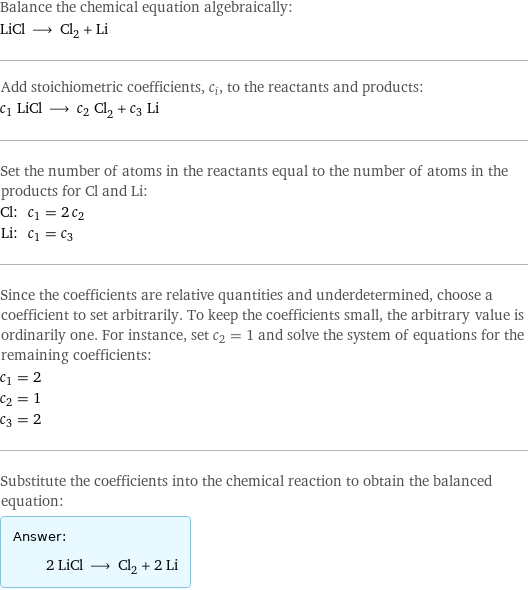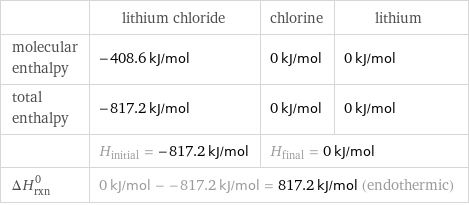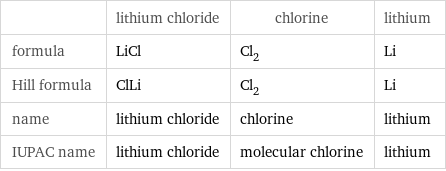Input interpretation

LiCl lithium chloride ⟶ Cl_2 chlorine + Li lithium
Balanced equation

Balance the chemical equation algebraically: LiCl ⟶ Cl_2 + Li Add stoichiometric coefficients, c_i, to the reactants and products: c_1 LiCl ⟶ c_2 Cl_2 + c_3 Li Set the number of atoms in the reactants equal to the number of atoms in the products for Cl and Li: Cl: | c_1 = 2 c_2 Li: | c_1 = c_3 Since the coefficients are relative quantities and underdetermined, choose a coefficient to set arbitrarily. To keep the coefficients small, the arbitrary value is ordinarily one. For instance, set c_2 = 1 and solve the system of equations for the remaining coefficients: c_1 = 2 c_2 = 1 c_3 = 2 Substitute the coefficients into the chemical reaction to obtain the balanced equation: Answer: | | 2 LiCl ⟶ Cl_2 + 2 Li
Structures

⟶ +
Names

lithium chloride ⟶ chlorine + lithium
Reaction thermodynamics
Enthalpy

| lithium chloride | chlorine | lithium molecular enthalpy | -408.6 kJ/mol | 0 kJ/mol | 0 kJ/mol total enthalpy | -817.2 kJ/mol | 0 kJ/mol | 0 kJ/mol | H_initial = -817.2 kJ/mol | H_final = 0 kJ/mol | ΔH_rxn^0 | 0 kJ/mol - -817.2 kJ/mol = 817.2 kJ/mol (endothermic) | |
Equilibrium constant
![Construct the equilibrium constant, K, expression for: LiCl ⟶ Cl_2 + Li Plan: • Balance the chemical equation. • Determine the stoichiometric numbers. • Assemble the activity expression for each chemical species. • Use the activity expressions to build the equilibrium constant expression. Write the balanced chemical equation: 2 LiCl ⟶ Cl_2 + 2 Li Assign stoichiometric numbers, ν_i, using the stoichiometric coefficients, c_i, from the balanced chemical equation in the following manner: ν_i = -c_i for reactants and ν_i = c_i for products: chemical species | c_i | ν_i LiCl | 2 | -2 Cl_2 | 1 | 1 Li | 2 | 2 Assemble the activity expressions accounting for the state of matter and ν_i: chemical species | c_i | ν_i | activity expression LiCl | 2 | -2 | ([LiCl])^(-2) Cl_2 | 1 | 1 | [Cl2] Li | 2 | 2 | ([Li])^2 The equilibrium constant symbol in the concentration basis is: K_c Mulitply the activity expressions to arrive at the K_c expression: Answer: | | K_c = ([LiCl])^(-2) [Cl2] ([Li])^2 = ([Cl2] ([Li])^2)/([LiCl])^2](../image_source/da0b740b0b549625438663ec98c31868.png)
Construct the equilibrium constant, K, expression for: LiCl ⟶ Cl_2 + Li Plan: • Balance the chemical equation. • Determine the stoichiometric numbers. • Assemble the activity expression for each chemical species. • Use the activity expressions to build the equilibrium constant expression. Write the balanced chemical equation: 2 LiCl ⟶ Cl_2 + 2 Li Assign stoichiometric numbers, ν_i, using the stoichiometric coefficients, c_i, from the balanced chemical equation in the following manner: ν_i = -c_i for reactants and ν_i = c_i for products: chemical species | c_i | ν_i LiCl | 2 | -2 Cl_2 | 1 | 1 Li | 2 | 2 Assemble the activity expressions accounting for the state of matter and ν_i: chemical species | c_i | ν_i | activity expression LiCl | 2 | -2 | ([LiCl])^(-2) Cl_2 | 1 | 1 | [Cl2] Li | 2 | 2 | ([Li])^2 The equilibrium constant symbol in the concentration basis is: K_c Mulitply the activity expressions to arrive at the K_c expression: Answer: | | K_c = ([LiCl])^(-2) [Cl2] ([Li])^2 = ([Cl2] ([Li])^2)/([LiCl])^2
Rate of reaction
![Construct the rate of reaction expression for: LiCl ⟶ Cl_2 + Li Plan: • Balance the chemical equation. • Determine the stoichiometric numbers. • Assemble the rate term for each chemical species. • Write the rate of reaction expression. Write the balanced chemical equation: 2 LiCl ⟶ Cl_2 + 2 Li Assign stoichiometric numbers, ν_i, using the stoichiometric coefficients, c_i, from the balanced chemical equation in the following manner: ν_i = -c_i for reactants and ν_i = c_i for products: chemical species | c_i | ν_i LiCl | 2 | -2 Cl_2 | 1 | 1 Li | 2 | 2 The rate term for each chemical species, B_i, is 1/ν_i(Δ[B_i])/(Δt) where [B_i] is the amount concentration and t is time: chemical species | c_i | ν_i | rate term LiCl | 2 | -2 | -1/2 (Δ[LiCl])/(Δt) Cl_2 | 1 | 1 | (Δ[Cl2])/(Δt) Li | 2 | 2 | 1/2 (Δ[Li])/(Δt) (for infinitesimal rate of change, replace Δ with d) Set the rate terms equal to each other to arrive at the rate expression: Answer: | | rate = -1/2 (Δ[LiCl])/(Δt) = (Δ[Cl2])/(Δt) = 1/2 (Δ[Li])/(Δt) (assuming constant volume and no accumulation of intermediates or side products)](../image_source/3923274324f62fbc1c3e7003b36358e1.png)
Construct the rate of reaction expression for: LiCl ⟶ Cl_2 + Li Plan: • Balance the chemical equation. • Determine the stoichiometric numbers. • Assemble the rate term for each chemical species. • Write the rate of reaction expression. Write the balanced chemical equation: 2 LiCl ⟶ Cl_2 + 2 Li Assign stoichiometric numbers, ν_i, using the stoichiometric coefficients, c_i, from the balanced chemical equation in the following manner: ν_i = -c_i for reactants and ν_i = c_i for products: chemical species | c_i | ν_i LiCl | 2 | -2 Cl_2 | 1 | 1 Li | 2 | 2 The rate term for each chemical species, B_i, is 1/ν_i(Δ[B_i])/(Δt) where [B_i] is the amount concentration and t is time: chemical species | c_i | ν_i | rate term LiCl | 2 | -2 | -1/2 (Δ[LiCl])/(Δt) Cl_2 | 1 | 1 | (Δ[Cl2])/(Δt) Li | 2 | 2 | 1/2 (Δ[Li])/(Δt) (for infinitesimal rate of change, replace Δ with d) Set the rate terms equal to each other to arrive at the rate expression: Answer: | | rate = -1/2 (Δ[LiCl])/(Δt) = (Δ[Cl2])/(Δt) = 1/2 (Δ[Li])/(Δt) (assuming constant volume and no accumulation of intermediates or side products)
Chemical names and formulas

| lithium chloride | chlorine | lithium formula | LiCl | Cl_2 | Li Hill formula | ClLi | Cl_2 | Li name | lithium chloride | chlorine | lithium IUPAC name | lithium chloride | molecular chlorine | lithium
Substance properties

| lithium chloride | chlorine | lithium molar mass | 42.4 g/mol | 70.9 g/mol | 6.94 g/mol phase | solid (at STP) | gas (at STP) | solid (at STP) melting point | 605 °C | -101 °C | 180 °C boiling point | 1382 °C | -34 °C | 1342 °C density | 2.07 g/cm^3 | 0.003214 g/cm^3 (at 0 °C) | 0.534 g/cm^3 solubility in water | | | decomposes surface tension | | | 0.3975 N/m dynamic viscosity | 0.00525 Pa s (at 20 °C) | |
Units
